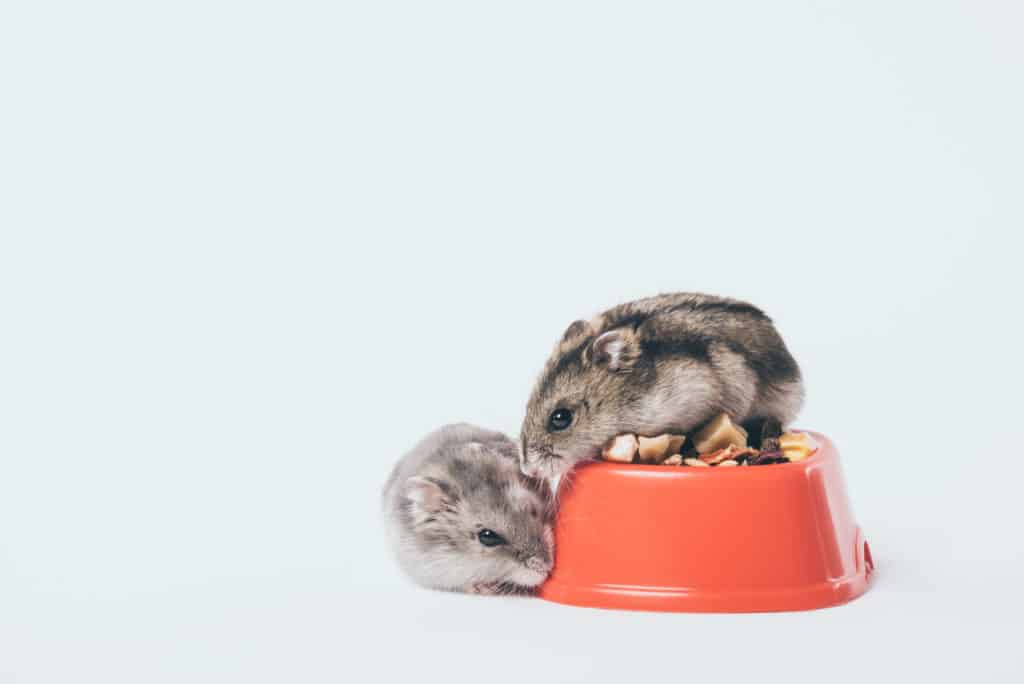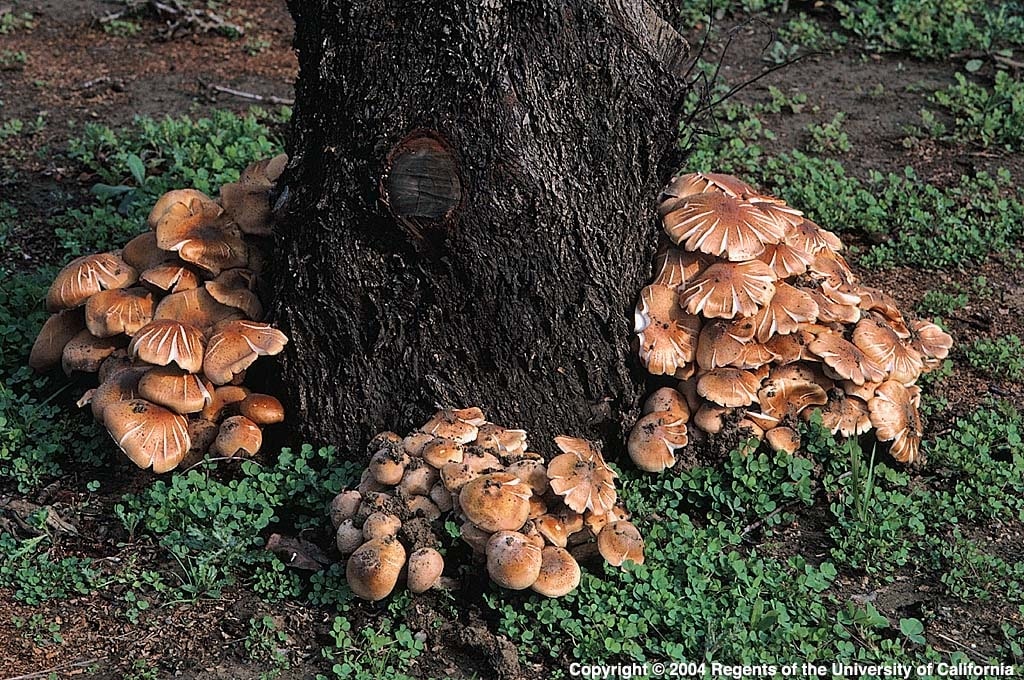If you are a hamster owner who loves mushrooms, you might have considered giving them to your hamster. But do you know if hamsters can eat mushrooms? What are the health benefits your hamster gets from eating mushrooms? What are the risks involved? How do you find out if it is safe for your hamster to eat mushrooms? Read this blog post and find out.
The nutritional content of Mushrooms
The nutrients in 100g of Mushrooms are listed below:
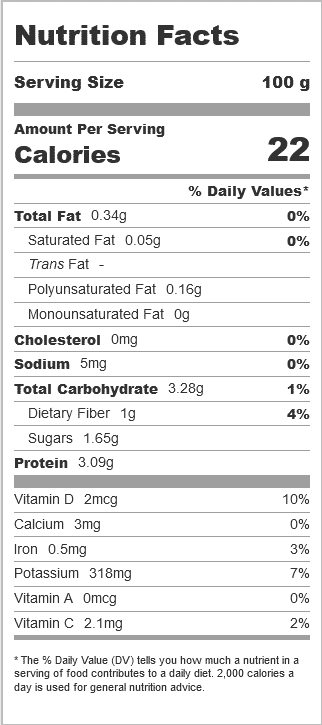
(Source: Fat secret)
Can hamsters have mushrooms? Are mushrooms safe for hamsters?
When it comes to feeding mushrooms to hamsters, the opinions of hamster owners differ significantly. Some feel that feeding mushrooms to hamsters is dangerous, while others feel it is okay to give mushrooms. You don’t have to give mushrooms to your hamster if you don’t want to. You can give other healthy vegetables like Asparagus (Read Can hamsters eat asparagus?) and spinach (Read Can hamsters eat spinach?).
Here, we have listed the advantages and disadvantages of feeding mushrooms to hamsters to help you decide. But even though this blog post lists factual information that is the result of our diligent research, we still recommend you consult a vet before making a decision.
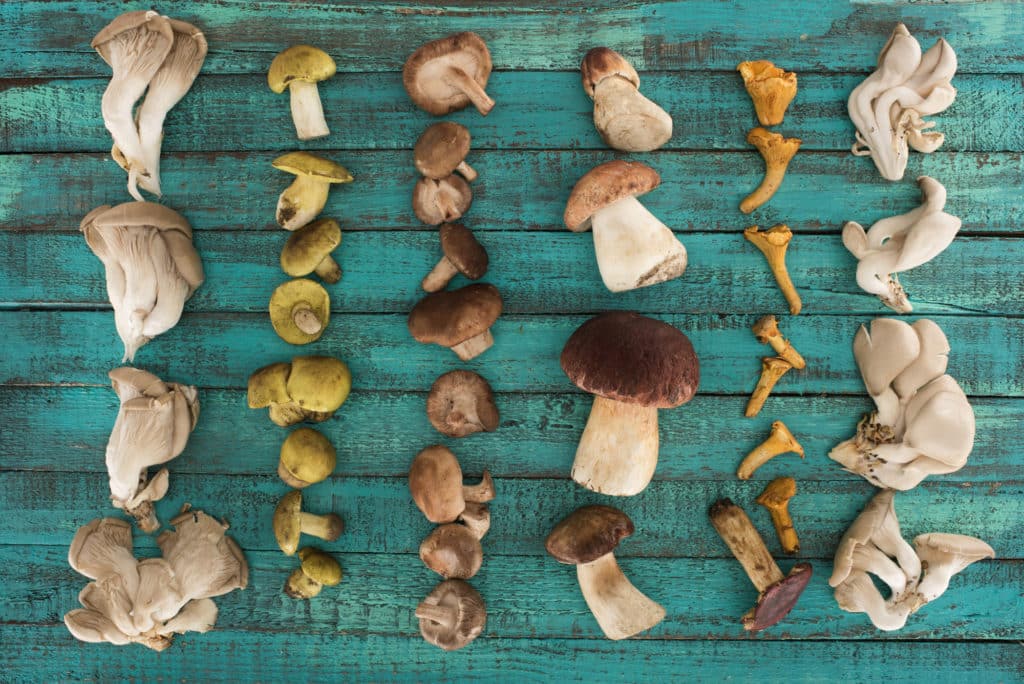
Health benefits of mushrooms
1. Mushrooms are rich in antioxidants. They are particularly rich in selenium, ergothioneine, and glutathione. Antioxidants protect the body from free radicals. Free radicals are unstable molecules that steal electrons from body cells, membranes, and DNA to become stable. By doing so, they can do irreversible damage to the body and cause diseases like cancer. But antioxidants neutralize free radicals before they can damage the body by providing them the electrons they need to become stable. The selenium present in mushrooms is a very powerful antioxidant. It is a much more powerful antioxidant than vitamin E, C, A, and beta-carotene (Source: PubMed). It protects your hamster from heart diseases and cancer. According to a recent study, ergothioneine and glutathione could protect the body from neurological diseases (Source: News Medical).
2. Mushroom contains small amounts of vitamin C, moderate amounts of vitamin D, and high amounts of B vitamins. Vitamin C is a vitamin that the body needs to create, develop and repair cells. It also improves the immune system and helps the body absorb iron. Vitamin D has many functions in the body. It helps the intestines absorb minerals like calcium and magnesium and compounds like phosphates. It helps bones and teeth remain strong and protects the body from many diseases. Mushrooms are also rich in the B vitamins B1, B2, B3, B5, and B9. These vitamins help the body convert food molecules into energy, help create red blood cells, and are necessary for the functioning of different organs.
3. Mushrooms are also rich in essential minerals. They contain high amounts of selenium and copper; and moderate amounts of iron, phosphorous, and potassium. Selenium is an element the body needs in trace amounts. It improves the immune system and prevents neurological disorders, heart diseases, and cancers (Source: Healthline). Copper is a mineral that helps produce red blood cells, maintain nerve cells, and boost the immune system (Source: Medical News Today). Iron helps the body create proteins that transport oxygen from the lungs to different parts of the body. It also helps create some hormones (Source: National Institute of Health). Phosphorous keeps the bones and teeth strong. It helps the muscles contract and recover after an exercise. It helps the kidneys filter and remove the waste from the body (Source: Medical News Today). Potassium is an element that benefits the heart and helps nerves function properly.
4. Beta Glucan is a soluble dietary fiber found in the cell walls of several types of mushrooms (Source: Healthline). It reduces high cholesterol and boosts heart health. It can also regulate body sugar, thereby reducing the risk of diabetes.
Risks
1. Campylobacter Jejuni, a bacterium occasionally found in commercially grown mushrooms, can cause food poisoning. This could happen if the mushroom was contaminated with this bacterium during the growing or storing phase. Food poisoning could also occur due to the cross-contamination of pathogens from eggs, raw meat, poultry, and seafood. Symptoms of food poisoning due to Campylobacter Jejuni include diarrhea, nausea, and abdominal cramps.
2. Mushrooms are easily perishable. So, if they aren’t properly stored, they can rot quickly. Sometimes, even canned mushrooms could have rotten before storage and distribution. Eating rotten mushrooms could cause food poisoning. Symptoms include vomiting, nausea, fever, watery or bloody diarrhea, and abdominal pain (Source: Live Strong). So, make sure you aren’t feeding old or rotten mushrooms to your hamster.
3. If your hamster can’t eat all the mushrooms you feed him, he might end up storing the extra mushroom secretly in his cage. So, check your hamster’s cage and remove any uneaten pieces of mushrooms promptly before they rot.
4. Mushrooms are acidic. So, eating too many mushrooms can hurt your hamster’s digestive system.
5. Fresh mushrooms bought from the store are generally safe for hamsters to eat. But feeding them mushrooms that you hand-picked from the wild could be dangerous. After all, only 3,000 of the 140,000 wild species of mushrooms are edible. So, you could end up picking a poisonous mushroom that might kill your hamster, or even worse, you.
6.. There are some species of mushrooms, called magic mushrooms, that could cause hallucinations. But that’s not all these mushrooms can do. They can also cause negative physical effects like nausea, vomiting, muscle weakness, etc. (Source: Live Strong). Possession of these types of mushrooms is illegal in several countries, including the USA.
Different breeds of hamsters vs. mushrooms
Just like all humans are not born equal, all hamsters are not born equal either. Different breeds of hamsters differ greatly in size. So, the amount of food they can eat varies. Therefore, the amount of mushrooms they can eat varies, too.
Can Chinese dwarf hamsters eat mushrooms?
Yes, Chinese hamsters can eat mushrooms. But remember that they are tiny hamsters. Hence, their digestive systems cannot handle the acidic content in mushrooms that well. So, they can’t eat too many mushrooms. You can probably give them a tiny piece of mushroom once a week.
Can Campbell dwarf hamsters eat mushrooms?
Yes, Campbell hamsters can eat mushrooms. But they can’t eat too many mushrooms in one go, like humans. They can probably eat a very small piece of mushroom once a week.
Can Russian dwarf hamsters eat mushrooms?
Yes, Russian hamsters can eat mushrooms. But as the name indicates, Russian dwarf hamsters are smaller compared to many other breeds of hamsters. So, they can only eat a tiny piece of mushroom once a week.
Can Roborovski hamsters eat mushrooms?
Yes, Robo hamsters can eat mushrooms. Roborovski dwarf hamsters are the smallest species of hamsters. But they are also the most active among pet hamsters. So, you can give them a slightly bigger piece of mushroom when compared to other dwaf hamsters, once a week.
Can Syrian hamsters eat mushrooms?
Yes, they can. And as the largest hamster breed, Syrian hamsters can eat much more compared to other hamster breeds. They can eat a piece of mushroom, the size of your small finger, once a week (Source: Just Hamsters).
FAQ
Can hamsters eat raw mushrooms?
Some of the most common mushrooms, including White-button, Portobello, and Cremini, are members of the species Agaricus Bisporus. Members of this species offer several health benefits like boosting immunity and reducing inflammation. But they also produce a toxic compound called Agaritine (Source: Trail Runner).
Even though consuming a handful of raw mushrooms is unlikely to cause any harm to humans, the same is not true for hamsters. Studies on rodents indicate that this compound can cause cancer. But cooking can eliminate the harmful effects of these mushrooms and boost their positive effects on health.
So, never give raw mushrooms to your hamster. Always give cooked mushrooms.
Can hamsters eat cooked mushrooms?
Yes, cooked mushrooms are safer than raw mushrooms. So, your hamster can eat them. But don’t add oil and spices while cooking a mushroom for your hamster. Oil can make your hamster fat, and spices can hurt his digestive system. You can give your hamster plainly (without any spices, salt, or seasoning) cooked, steamed, or boiled mushrooms. But again, the quantity matters. You should only give a small piece of mushroom, that too, only occasionally.
Can hamsters eat wild mushrooms?
As mentioned before, only 3,000 of the 140,000 wild species of mushrooms are edible. The rest are poisonous. So, unless you are an expert botanist, there is no way for you to know if the mushroom you randomly picked from a forest or garden is poisonous or not. The chances are pretty high for the mushroom to be poisonous. So, never give a wild mushroom to your hamster.
Can hamsters eat White Button mushrooms?
Yes, because White button mushrooms are one of the safest mushrooms for your hamster to eat. But before feeding a White button mushroom to your hamster, you should cook it properly.
Can hamsters eat Shiitake mushrooms?
Yes, Shiitake mushrooms are also safe for your hamster to eat. But again, you should cook the mushroom before giving it to your hamster.
Which type of mushroom is the best for my hamster?
The best mushrooms to give your hamsters are White button mushrooms and portobello mushrooms (Source: Tiny pet tales).
How to introduce mushrooms into your hamster’s diet?
As with any other treat, you have to introduce mushrooms slowly into your hamster’s diet. Not every hamster would love the taste of mushrooms. Some hamsters could even be allergic to mushrooms. Mushrooms might even be hard to digest for your hamster.
So, start with a very small piece of mushroom. If your hamster eats it and doesn’t suffer from stomach upset or diarrhea for the next 48 hours, then you can increase the amount slowly over the next few weeks until you reach the recommended amount. However, if your hamster throws up or suffers from diarrhea, consult a vet immediately.
Fun Facts
What are mushrooms?
Mushrooms are fungi. They belong in a kingdom of their own (Source: The government website of British Columbia). They are neither considered plants nor considered animals because the way they obtain their nutrients differs significantly from plants and animals. Plants produce their own food using the sun’s light through the process of photosynthesis. Animals eat other animals or the food produced by plants and digest them internally. But mushrooms do neither of these.
Mushrooms need nutrients to survive. But they don’t have stomachs to digest food. So, their mycelium grows into or around the food source and secretes enzymes. These enzymes digest the food externally, and the digested nutrients are then absorbed by the mycelium.
The mushroom is the reproductive part of these fungi. It is similar to the fruit of a plant. The seeds of the fungi are the millions of minuscule spores produced by the pores underneath the mushroom’s cap. Blowing wind and the animals that eat the mushroom spread the spores.
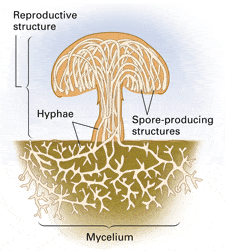
When these spores land on a suitable surface, like wood or soil, they germinate and form a network of microscopic roots called mycelium. Even though the mushroom withers away quickly, the underlying mycelium can survive for several years, extracting nutrients from the source and producing mushrooms every year.
Different categories of mushrooms
Mushrooms can be categorized into the following varieties based on how they live (Source: The government website of British Columbia).
1. Saprotrophs – This type of mushroom decays dead plants and animals and convert organic matter into inorganic matter. They can digest materials like wood and break them down into the basic components of forest soils.
Any forest contains a lot of dead leaves and wood. These dead materials contain the nutrients that the flora in forests need to flourish. Mushrooms break these dead materials into nutrients that other plants can later absorb. Without mushrooms, this process would be slowed terribly, and the plants and trees in the forests would slowly die as they are starved from the nutrients. Thus, these mushrooms help new life emerge from old, dead life.
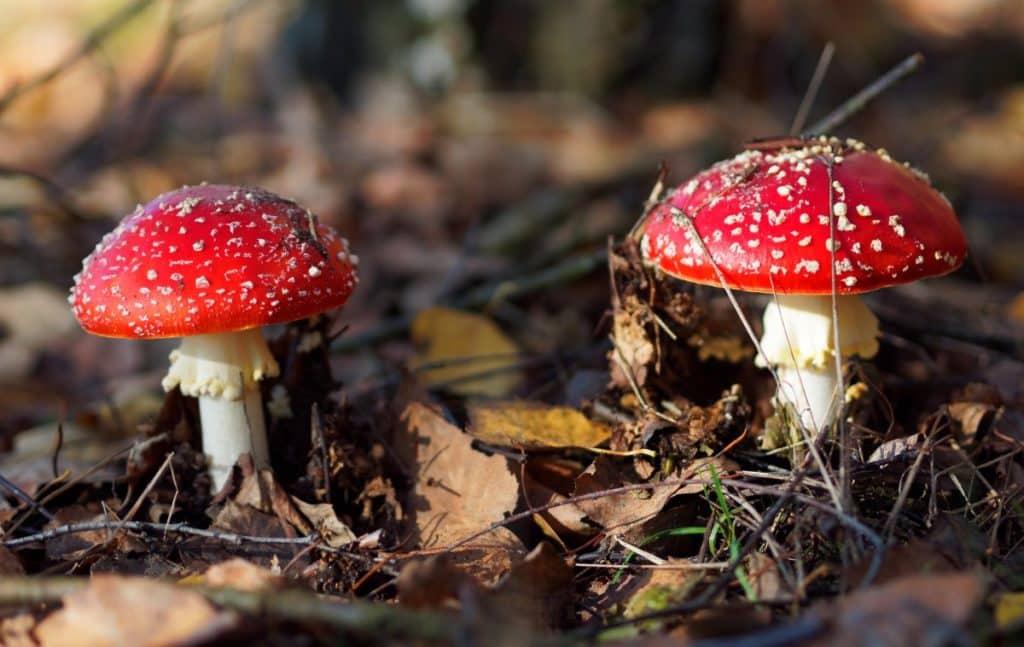
But dead leaves and wood aren’t the only things these bad boys can digest. Their mycelium can grow deep into the soil. They can absorb nutrients from the soil until there is nothing more left. They eat away bacteria and break down harmful substances. So, they can be used to remove pollutants from soil, destroy algae in lakes, clean up oceans after an oil spill by breaking down the hydrocarbons that occur in oil, and even break down plastics (Source: CRCLR).
2. Mycorrhizae – Mycorrhizal mushrooms form partnerships with the roots of trees. Their mycelium weaves itself around the roots of trees and actually changes the shape of these roots. This is a symbiotic relationship since both the mushroom and the tree benefit from this partnership (Source: Trees Atlanta). The mushroom absorbs water and nutrients for the tree, while the tree gives mushrooms carbohydrates produced through photosynthesis. The mushroom can extend the range of a tree’s roots. So, trees and plants which form mycorrhizal partnerships with mushrooms can grow faster and stronger.
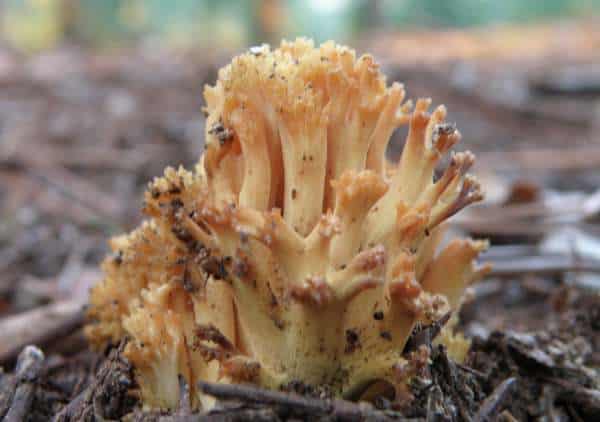
But this is not the full extent of this symbiotic relationship. The mycelium of a mushroom doesn’t connect with just one tree. It connects with multiple trees. By doing so, it helps trees exchange nutrients and communicate with each other.
These mushrooms can be seen growing under trees along the direction of their roots.
3. Parasites – While there are mushrooms that form a symbiotic relationship with the roots of trees, there are also mushrooms that do the exact opposite – They act as parasites. Just like mycorrhizal mushrooms, parasitic mushrooms, too, need a host tree to survive. But unlike mycorrhizal mushrooms, they only take food from the trees; they don’t give anything in return. They feed on the roots and trunks of healthy trees, weakening them and eventually killing them.
But trees are not the only life-forms parasitic mushrooms can infest. They can also infest insects, like the caterpillar, kill them, and grow out of the dead insect.
4. Endophytes – Just like parasitic mushrooms, endophytic fungi, too, invade the tissues of their host trees. But instead of weakening its host trees, it makes them stronger by increasing their pest resistance and nutrient absorption abilities (Source: Grocycle). Some types of endophytic fungi don’t even produce mushrooms.
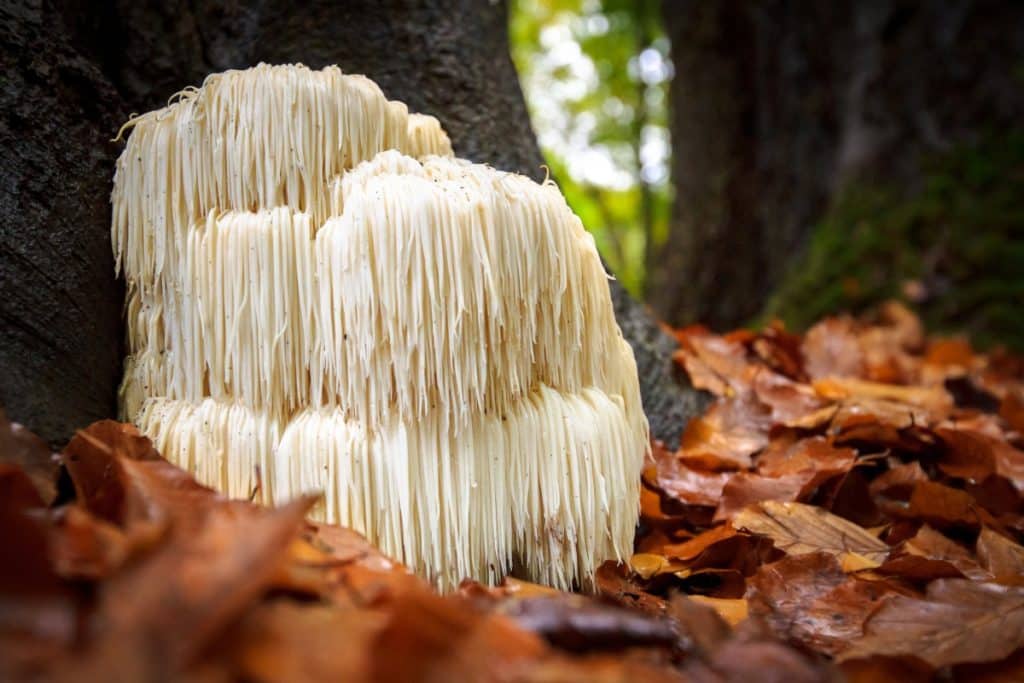
5. Food – The nutrients absorbed by the mycelium help the mushroom grow. Many types of mushrooms (which can also fall into any category above) are edible. Some animals, especially rodents like squirrels, rely on them for food. There are some insects, like a type of fly, which spend their entire lives in mushrooms.
6. Poison – While many species of mushrooms are edible and highly nutritious, there are others that are poisonous. As a matter of fact, there are more species of poisonous mushrooms than edible mushrooms. Out of the 140,000 species of mushrooms that grow in the wild, only 3,000 are edible.
The degree of poisoning could also vary depending on the species. Some might just cause stomach upset, while others might cause organ failure resulting in death. Moreover, some symptoms might be instantaneous, while some might take several days or weeks to show up.
Origin
Fungi first appeared about a billion years ago (Source: Grocycle). Nobody knows exactly when our ancestors started eating mushrooms. They probably started eating mushrooms in the hunting and gathering period, far before the first written records started to appear.
For a long time, mushrooms were considered supernatural. 4,600 years ago, the Egyptians thought that eating mushrooms would make a person immortal. So, they reserved it for their Pharaohs. Ancient Greeks and Romans considered mushrooms to be the food of their gods. On the other side of the globe, the Chinese and the Japanese consumed mushrooms for thousands of years due to their medicinal uses.
But despite consuming mushrooms for millennia, humans never figured out how to cultivate them. The first mushrooms were cultivated in China between 300 and 200 BC. But it would take 2,000 more years for mushroom cultivation to spread to Europe.
In Europe, mushroom cultivation first began in Paris around 1,650 AD (Source: Low Impact). From there, it spread to England, and finally, in 1,865 AD, the USA began mushroom cultivation.
Summary – Key Takeaways
Mushrooms are neither plants nor animals; they are fungi. They offer several health benefits to the body.
1. Mushrooms contain some powerful antioxidants like selenium, ergothioneine, and glutathione. They can protect the body from heart diseases, neurological disorders, and cancer.
2. Mushrooms contain many essential vitamins – B1, B2, B3, B5, B9, C, and D. These vitamins help the body break down food molecules to obtain energy, keep the bones and teeth strong, and improve immunity.
3. Mushrooms contain minerals like selenium, copper, iron, phosphorous, and potassium. These minerals prevent various diseases, boost the immune system, and help the bones, teeth, blood, nerves, and kidneys function properly.
4. The soluble dietary fiber found in mushrooms can help fight against diabetes and heart diseases.
Yet, despite all their health benefits, some pet owners still feel that mushrooms are not safe for their hamsters. So, they don’t give mushrooms to their hamsters. Other pet owners feel that mushrooms are safe, and they give mushrooms to their hamsters. So, if you are still on edge about giving mushrooms to your hamster, consult a vet. But if you’ve already decided to give mushrooms to your hamster, the steps below will help you.
How to give mushrooms to your hamster?
1. There are many toxic mushrooms in the wild. So, never give your hamster a mushroom you randomly picked from the forest.
2. White button mushrooms and portobello mushrooms are the safest mushrooms for your furry friend.
3. Cook the mushroom before giving it to your hamster because raw mushrooms could contain a poisonous compound called Agaritine. Steamed or boiled, unsalted, and unseasoned mushrooms are the safest for your hamster.
4. Mushrooms contain an acid called Pantothenic acid that can affect your hamster’s digestive system. So, feed only small amounts of mushrooms and that too, occasionally to your hamster.
5. If your hamster suffers from stomach upset, abdominal pain, or diarrhea after eating mushrooms, consult a veterinary doctor immediately.
6. Mushrooms can rot quickly. So, check your hamster’s cage to make sure that he hasn’t stored any excess mushroom pieces to eat later. If you find such pieces, dispose of them immediately.
